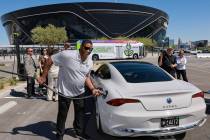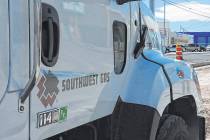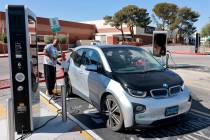Electric vehicles are nothing new
Editor's note: Stan Hanel is a veteran of the electronics industry and active advocate of electric vehicle technologies. This column is the first of a regular series that will appear in Drive.
Electric cars might seem like a dream of the future, but some of the very first cars were battery-powered electric vehicles.
More than 100 years ago, during the turn of the last century from 1880 to 1930, three types of technologies from the industrial revolution competed to usher in the era of the horseless carriage -- steam engines, internal combustion engines and battery-powered electric motors.
Electric motors and battery technologies provided the most popular automotive platform during the first decade of the 1900s, especially in urban areas. Motors, batteries and recharging systems from industrial factory machinery were readily available and easily adaptable to horseless carriages. Dirt and gravel roads limited vehicle speeds, but electric cars, without much maintenance, could still travel faster than a horse. The 1902 Woods Phaeton had a range of 18 miles, a top speed of 14 miles per hour, and a cost of $2,000. In 1916, the Woods auto manufacturers also produced a hybrid car that employed both an electric motor and an internal combustion engine for extended-range driving.
Thanks to Thomas Edison, Nikola Tesla and other inventors of the time, electricity was becoming more readily available to local households through regional generating stations and distribution systems. A flip of a switch next to the driver's seat was all it took for an electric car to quickly start moving from a standing stop, thanks to the inherent torque available from its electric motor. The electric cars' quiet, elegant operation seemed more efficient and was preferred by female drivers. An electric car could be recharged, when not in use, from the same electrical power in the household that was available for lighting and other appliances.
At the same time, internal combustion engine technology, which could use either gasoline or diesel fuels, showed greater energy density to weight ratios than electrochemical batteries or compressed steam tanks. However, internal combustion engines initially required vehicle drivers to physically crank the pistons to start the internal combustion process, sometimes causing injuries to vehicle owners. It wasn't until the invention of the electric motor starter system by Charles Kettering in 1912 that the benefits of ICE technology became more reliable.
Henry Ford pioneered the modern assembly line, eventually taking advantage of economies of scale to sell his Model T for $500. This lower price made automobiles more affordable to a wider market of consumers at one-eighth the cost of steam-powered vehicles and about half the cost of electric hand-built automobiles. The oil production and refining industries became the primary fuel sources for automotive platforms in the USA, exhibiting the best combination of price, automobile range and power.
However, before the ascendance of the Model T after 1910, electric vehicles were so well accepted in the early 20th century that they made regular appearances in the popular media of the time. During the early 1900s, Victor Appleton began publishing a series of short stories about a remarkable boy inventor and action hero named Tom Swift.
In "Tom Swift and his Electric Runabout," the writer imagines and chronicles in detail some of the same design decisions that electric car manufacturers wrestle with today. During the 94-page short story, Tom designs and builds an electric car that exceeds 100 miles per hour and, among other things, competes against other electric cars in a 500-mile endurance race. Tom's electric runabout is faster than many of the gasoline and other electric automobiles of his time.
Some of Tom's design decisions reflected the perceived potential of electric automotive technology at the turn of the century, including the use of Edison's nickel-iron batteries instead of lead-sulfuric acid batteries for increased range. One twist to Tom Swift's battery design strategy in 1910 was to improve Edison's potassium hydrate electrolyte chemistry by adding lithium hydrate to make it stronger. The successful development of lithium-ion batteries in the 21st century is now perceived by electric car designers as a "holy grail" that would provide four times the driving range of a conventional lead-acid battery pack during each discharge cycle and 20 times more recharging cycles during the pack's lifespan.
Other forward-looking design decisions made by Tom Swift included the use of a chain drive from the electric motor power train to the wheels instead of a direct drive shaft; installation of a two-speed gear box and shifting mechanism; location of the battery pack and motor to provide for a low center of gravity; the use of aerodynamic shapes on the front of the runabout's body to provide the least wind resistance; and the fabrication of an "opportunity" battery recharging system that could draw electric current from a trolley line or electric street lamp during emergencies as well as from conventional charging stations.
Aerodynamics, battery improvement and recharging systems are also modern concerns. Currently, Israeli engineers are working on developing an "electric road" embedded with crystals that create energy when electric vehicles drive over them, similar to Swift's "opportunity" recharging system.
Today's high-performance electric cars, such as the Tesla Motors Roadster, are pushing new electric vehicle technologies into the 21st century. The Roadster's power train consists of a 375-volt AC induction electric motor with electronic variable frequency motor speed controller and a single-speed fixed gear system. The battery pack consists of 6,831 battery cells that are all monitored by a microprocessor control system inside a custom-built package that has a guaranteed life cycle warranty of five years or 100,000 miles. The power train system can provide 248 peak horsepower (at 185 kilo-Watts) and 276 pounds per feet of torque, allowing the Roadster to accelerate from zero to 60 mph in under 4 seconds. Range is about 220 miles, based on EPA combined city/highway cycles. The battery pack can be recharged overnight from a standard 220-volt AC outlet rated at 20 amps or in about 3.5 hours from a Tesla Motors High Power Connector charging station that can pump 70 amps of current to the battery pack.
Despite the Tesla Roadster's high cost of more than $110,000 and limited highway range, the car is a progressive benchmark for the electric-powered automotive world to come. The ride demonstrates a unique feeling of on-demand torque throughout the power train spectrum, as described in words by Victor Appleton 100 years ago.
Stan Hanel has worked in the electronics industry for more than 30 years and is a long-time member of the Electric Auto Association and the Las Vegas Electric Vehicle Association. Hanel writes and edits for EAA's "Current EVents" and LVEVA's "Watts Happening" newletters. Contact him at stanhanel@aol.com.

















